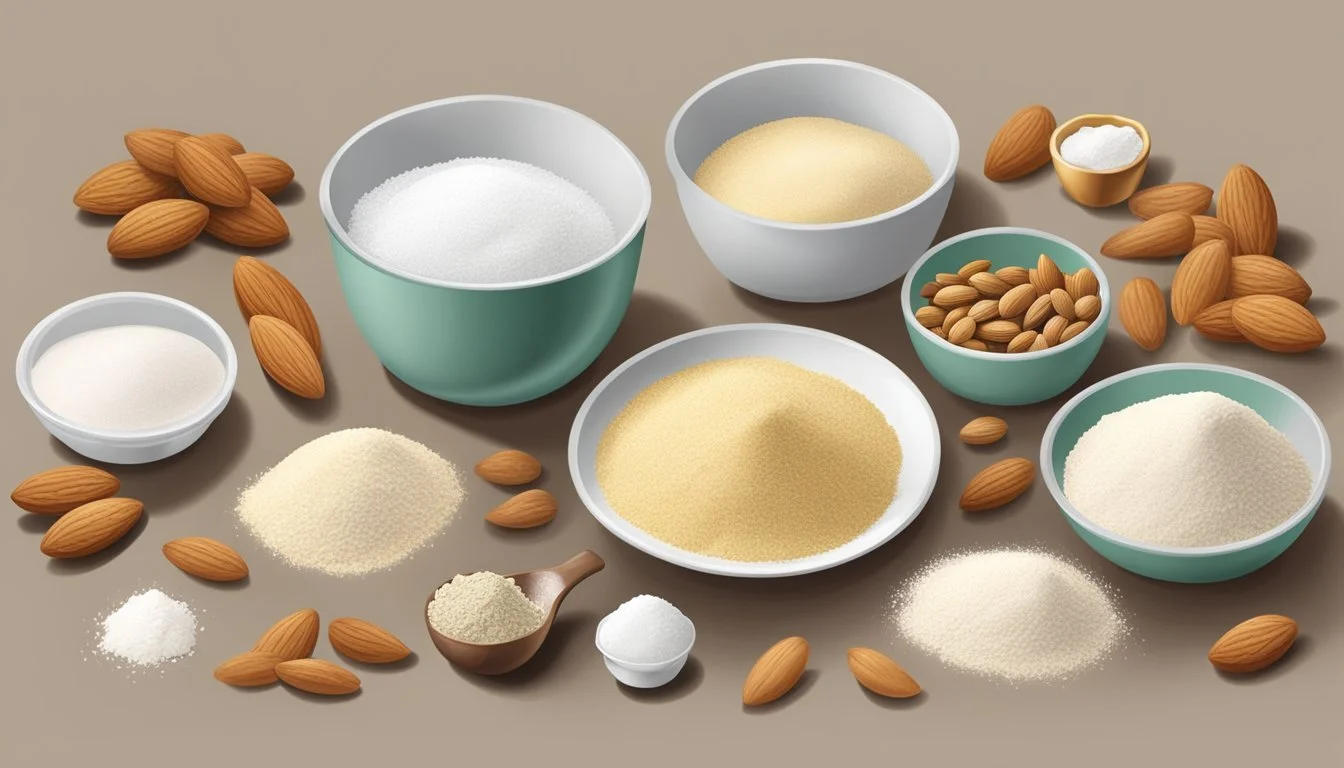Marzipan Substitutes
Top Alternatives for Almond Paste Baking
Marzipan, a confection traditionally composed of sugar or honey and ground almonds, often finds its place in various desserts and sweet treats, particularly those of European origin. Boasting a smooth texture and sweet, nutty flavor, it is a versatile ingredient used in decorations, baking, and as a filling in chocolates among other delicacies. Crafting marzipan requires a balance of almonds and sweetness, creating a pliable paste that can be easily sculpted or rolled out to coat cakes.
Despite its popularity, marzipan may not always be readily available or suitable for all dietary preferences. Fortunately, there are several substitutes that can step in to fulfill similar roles in recipes. These alternatives, while different in composition, aim to replicate the distinctive taste and texture of marzipan to some extent. Almond paste, for instance, is a good stand-in due to its similar almond content and sweetness, though it has a coarser texture and is less sweet than marzipan, making it ideal for incorporating into baked goods rather than for decorative purposes.
For those looking to avoid almonds or seeking a different flavor profile, other substitutes such as a combination of icing sugar, semolina, and egg white flavored with almond essence or vanilla can provide a marzipan-like consistency. Options like coconut marzipan, which uses coconut in place of almonds, exist too, expanding the possibilities for both taste and dietary variation. These alternatives offer bakers and confectioners the flexibility to adapt their creations when traditional marzipan is not an option.
Understanding Marzipan
This section explores the components of marzipan, its health considerations, and cultural significance. The reader will gain a comprehensive understanding of this confection.
Marzipan Ingredients
Marzipan is a confection primarily composed of sugar and ground almonds. Almond paste, which shares similar ingredients, is often conflated with marzipan but is less sweet and has a coarser texture. Marzipan's smooth, pliable nature allows for its use in decorative cake covering and sweet figurines.
Almond Allergies and Health Considerations
People with nut allergies, specifically to almonds, should avoid marzipan due to its almond content. For those not allergic, marzipan can be part of a balanced diet, though its high sugar content calls for moderate consumption. Health considerations also include the supply of essential nutrients such as vitamin E and dietary fiber from the almonds.
Marzipan in Culture
Marzipan finds its roots in Europe, the Mediterranean, and Middle Eastern culinary traditions. It is a staple in festive and holiday baking. Its versatility is celebrated in various European cultures, particularly in Germany and Italy, where it has been crafted into an art form with intricate designs and sculptures.
Common Marzipan Substitutes
Finding the right marzipan substitute can help maintain the desired sweetness and texture in recipes, offering variations in both flavor and dietary compatibility.
Nut-Free Alternatives
For those with nut allergies or preferences, coconut paste serves as an excellent nut-free marzipan substitute. It is comparable in texture to marzipan and provides a similar sweetness level, while imbuing a distinct coconut flavor to dishes. Another option is fondant, a mixture mainly of sugar, water, and cream of tartar, which can be rolled and shaped like marzipan, but lacks the nutty essence.
Sweetness and Flavor Variants
Substitutes may vary in their sweetness and flavor profiles. For a closely related consistency and taste, almond paste, despite being sweeter, shares many of marzipan’s primary ingredients like almonds and sugar, with added egg whites for binding. Another variant, chestnut paste, provides a unique, nutty flavor different from almond yet akin to marzipan's texture and is sweetened with sugar or syrup.
Vegan and Dietary Substitutes
When catering to vegan or other dietary requirements, choosing an appropriate substitute is crucial. Eggless marzipan recipes might combine icing sugar, almond essence, and a vegan egg replacer. Ingredients like almond butter can also mimic the texture and nutty taste of marzipan whilst being vegan-friendly, although adjustments may be needed to achieve the exact consistency and sweetness of traditional marzipan.
Homemade Marzipan Substitutes
Marzipan is a versatile ingredient often used in baking and confections. When it is not available, or dietary restrictions apply, homemade substitutes can offer practical and customizable alternatives.
Creating Nut-Free Marzipan
For those with nut allergies, creating a nut-free version of marzipan involves using seeds or grains as a base. Pumpkin seeds or sunflower seeds, ground into a fine powder, can mimic the texture of almond flour. Use:
1 cup of ground seeds
1 ½ cups of icing sugar
2 teaspoons of corn syrup
Water as needed for consistency
Blend the ground seeds and icing sugar, then add corn syrup and water slowly until a paste forms. This can be used in desserts where a nut-free marzipan is essential.
Vegan Substitute Recipes
Vegan marzipan relies on avoiding products like egg whites. For a simple vegan substitute, the chef needs:
1 ½ cups of almond flour
1 ½ cups of icing sugar
2 tablespoons of coconut butter
1 teaspoon of almond extract
2 tablespoons of light corn syrup
Mix the almond flour and icing sugar, add the coconut butter and almond extract for flavor, and use corn syrup to achieve the right consistency.
Substitutes for Specific Dishes
For specific dishes requiring marzipan-like textures and flavors, adjustments can be tailored:
Cake Decorations: Use a blend of refined almond paste or coconut paste with icing sugar and corn syrup for creating shapes and figures.
Baked Goods: To fill pastries, combine almond butter with light corn syrup and icing sugar to match marzipan's sweetness and texture.
The chef can experiment with the ratio of these ingredients to cater to the sweetness and consistency needed for their particular dessert recipe.
Substitute Ingredients Overview
When seeking alternatives for marzipan in recipes, one should consider the sweetness level, texture, and flavor profile of the substitutes. The goal is to achieve a balance that mimics marzipan's unique qualities while accommodating for dietary restrictions or ingredient availability.
Alternative Sweeteners
Sugar: Refined sugar is the base for most marzipan substitutes, providing the necessary sweetness. However, for a healthier option, one might opt for honey or artificial sweeteners like Stevia. These alternatives can adjust the sweetness without altering the texture significantly.
Refined Sugar: Essential for sweetness; can use equal parts compared to marzipan
Honey: Natural sweetness with a distinct flavor; start with half the amount and adjust to taste
Artificial Sweeteners: Varying by type, some may be sweeter than sugar; use sparingly
Substitute Textures
The texture of marzipan is firm yet pliable. Ingredients such as almond paste, butter, and coconut paste offer similar consistencies. For those seeking a vegan substitute, replacing egg whites (often found in almond paste) with 1 tablespoon of egg replacer or lemon juice can help achieve the desired texture while maintaining the binding property.
Almond Paste: Similar texture, usually requires less sugar due to its inherent sweetness
Butter: Can impart a rich, creamy texture often used in conjunction with powdered sugar
Coconut Paste: Offers a comparable texture with a tropical twist; roll to desired thickness
Substitute Flavors
Marzipan's flavor is predominantly almond, but substitutes offer a range of taste profiles. Vanilla and almond essence provide similar notes, while rose water or orange flower water can bring a floral dimension to the dish. For a distinct flavor shift, one can use coconut in the form of paste or extract, especially suitable for those looking for non-almond based alternatives.
Vanilla Essence: Provides a warm, universally favored taste
Almond Essence: Directly mimics the core flavor of marzipan
Rose Water: Delicate and aromatic; use sparingly to avoid overpowering
Coconut: Imparts a unique flavor, best used when coconut is complementary to the recipe
Marzipan Substitute Applications
Marzipan is a versatile ingredient often used in various culinary applications, from baked goods to confectioneries. A suitable substitute should match the consistency and the flavor profile of marzipan where necessary.
Substitutes in Baking
Almond Paste: For recipes such as almond croissants and other desserts that call for a rich almond flavor, almond paste serves as an excellent alternative. Unlike marzipan, it contains less sugar and more almonds, resulting in a less sweet, but still complementary taste for baked goods.
Custard Powder Mixture: A creative mix for marzipan replacements in baking involves custard powder, an egg white or substitute, and almond essence. This concoction matches the moisture of marzipan in cakes and pastries, while imparting a familiar sweetness.
Substitutes in Candy-making
Coconut Paste: For candy-making, particularly for Easter and Christmas treats that require a marzipan-like consistency, coconut paste can be used. Its inherent sweetness and pliability make it suitable for molding chocolates and other confections.
Fondant: When it comes to creating candies that demand a smooth texture, fondant can take the place of marzipan. Available in various colors, it also serves as an excellent medium for making festive candies that are eye-catching and palatable.
Decoration Substitutes
Almond Paste: As the closest substitute for marzipan, almond paste can be rolled and shaped for decoration on cakes and desserts. It holds color well, making it a suitable option for themed cake decorations.
Fondant: For those looking to achieve detailed decorative work on their desserts, such as floral arrangements or intricate designs, fondant provides the necessary flexibility and ease of use that decorators require. It can be dyed with food coloring to achieve a vast array of hues, perfect for any occasion.
This section has highlighted substitutes that can be implemented in various culinary traditions, while closely respecting the unique roles that marzipan plays in baking, candy-making, and decoration.
Technical Aspects of Substitutes
When considering substitutes for marzipan, several technical aspects are crucial. These include how the substitutes are processed, their texture and consistency, and the impact on flavor, including aftertaste.
Food Processing Techniques
Substitutes for marzipan often involve different food processing techniques. Almond paste, for instance, requires blanched almonds that are ground using a food processor. The addition of sugar and a binding agent, like egg white or corn syrup, is then mixed in to create a paste with a consistency similar to marzipan.
Almond paste: Food processor → Ground almonds + Sugar + Binding agent
Texture and Consistency
The texture and consistency of a marzipan substitute are determinant for its appropriateness in a recipe. Almond paste tends to have a denser and coarser texture due to its lower sugar content and higher moisture when compared to marzipan.
Almond paste: Denser and coarser
Substitutes: Must mimic marzipan's smooth, pliable texture
Flavor Pairing and Aftertaste
Marzipan substitutes should complement the flavors of the dish without overwhelming it. Almond paste offers a nutty flavor that is less sweet than marzipan but can achieve a similar flavor profile when used in the right quantities. The aftertaste should not diverge significantly from marzipan's light almond essence.
Key Flavor: Nutty flavor
Consideration: Subtle aftertaste, avoiding bitterness
Nutritional Considerations
When considering marzipan substitutes from a nutritional standpoint, it's important to assess the health benefits, sugar content, and allergy considerations of each alternative. This helps ensure that the substitute aligns with dietary needs and preferences.
Substitute Health Benefits
Marzipan substitutes can offer varied health benefits depending on their ingredients. For example, almond paste, which is primarily ground almonds, sugar, and sometimes egg whites, provides a good source of healthy fats, protein, and fiber. These nutrients are essential for heart health and digestion. Sugar-free options, using sweeteners like Splenda, also exist for those monitoring their sugar intake, potentially reducing the risk of sugar-related health issues.
Comparing Sweetness Levels
Substitutes vary in their sweetness due to the different types and amounts of sweeteners used:
Almond paste is generally sweeter than marzipan because it contains a higher sugar ratio.
For a less sweet option, one can make a homemade substitute using ingredients like semolina and custard powder, which have an inherently lower sweetness level.
Table: Sweetness Comparison
Substitute Sweetener Used Relative Sweetness Almond Paste Sugar High Homemade Mix Custard Powder Low-Medium Sugar-Free Mix Artificial Sweetener Low
Allergy-Specific Substitutes
Those with nut allergies or an aversion to almond taste might seek almond-free marzipan substitutes. One can make an almond-free version by using semolina or custard powder as a base, which avoids common allergens and replicates the texture without the nut content. It's important to check labels on commercial substitutes for potential cross-contamination with nuts if allergies are a concern.
Marzipan Substitute Tips and Tricks
When substituting for marzipan, it's important to understand the culinary role marzipan plays in a recipe due to its unique flavor, texture, and how it interacts with other ingredients.
Expert Advice
Experts often recommend almond paste as the best substitute for marzipan, as its ingredients—blanched almonds, sugar, and sometimes egg whites—closely match marzipan's profile. While marzipan is sweeter and often contains added almond extract for a more intense flavor, almond paste can be enhanced with additional sugar or almond extract to achieve a closer match to marzipan's distinct taste.
Flavor Adjustment:
If using almond paste, consider adding a drop or two of almond extract to bolster the almond flavor.
Vanilla extract can serve as a substitute to add depth to the sweetness if almond extract is not available.
European Pastry Adaptations
In European pastries that traditionally include marzipan, maintaining the original texture and flavor profile is crucial. A substitute like tofu blended with almond extract can mimic marzipan's fudge-like texture and is a viable option for those with nut allergies. Tofu's neutral taste absorbs flavors well, making it an innovative base for a marzipan alternative.
Texture Focus:
For a denser consistency, similar to marzipan, mix pureed tofu with icing sugar and glucose syrup until a pliable texture is achieved.
Troubleshooting Substitutes
Attempting to replace marzipan may sometimes result in unexpected textures or flavors. One must be prepared to make adjustments as necessary:
If the substitute is too crumbly or dry, adding a small amount of glucose syrup can help achieve a more malleable and moist consistency.
In cases where the flavor is too subtle, increase the concentration of almond or vanilla extract incrementally, tasting between adjustments.
Remember, the aim when substituting for marzipan is to replicate its sweet, nutty flavor and its versatile, fudge-like texture as closely as possible within the context of the specific pastry or dessert.






